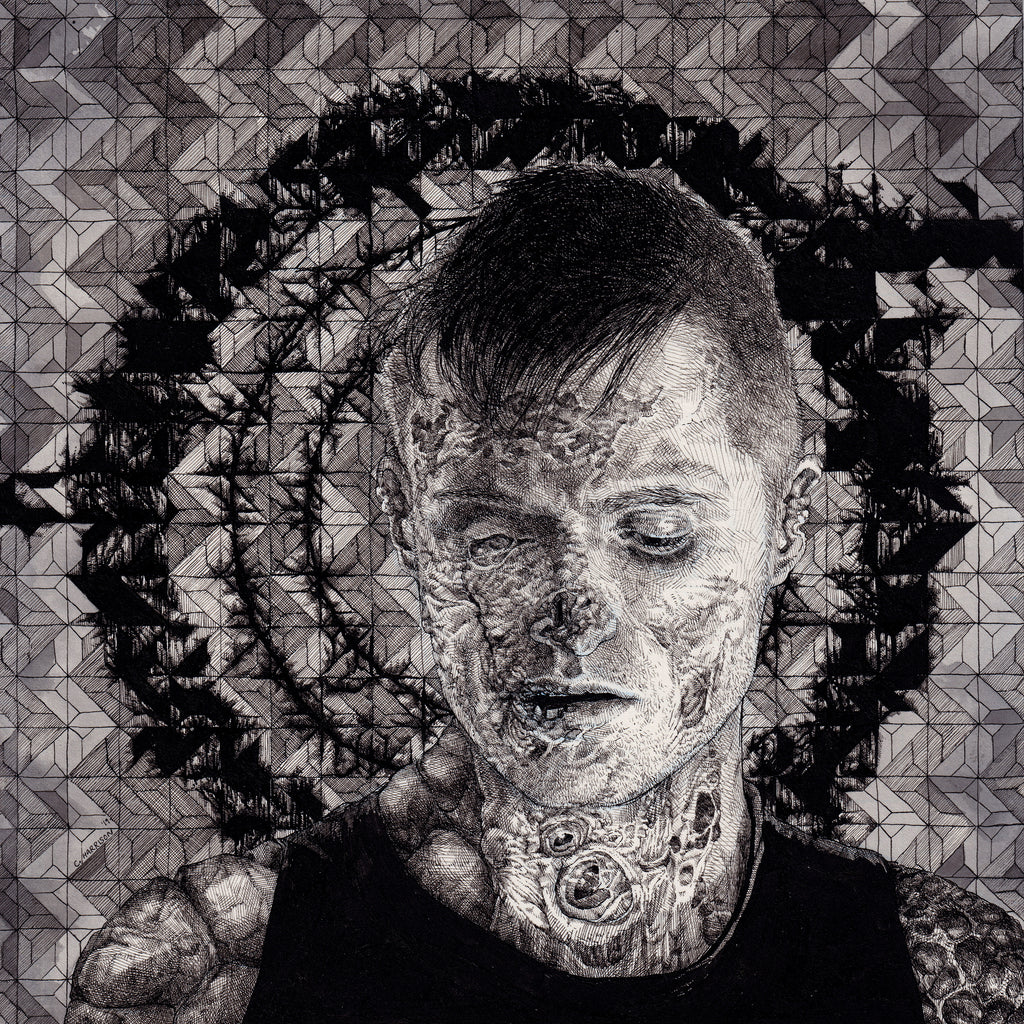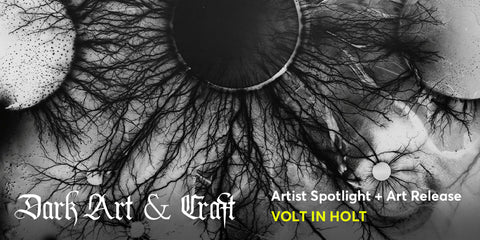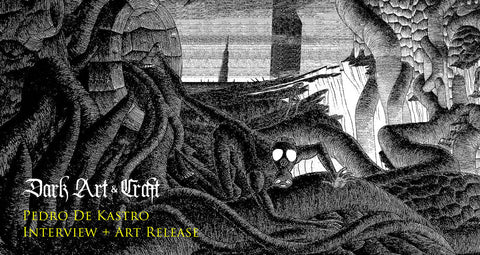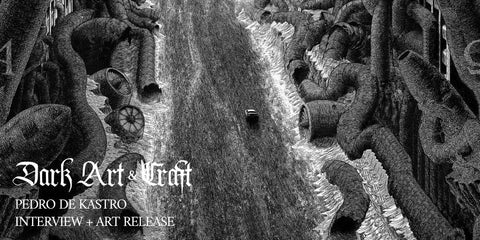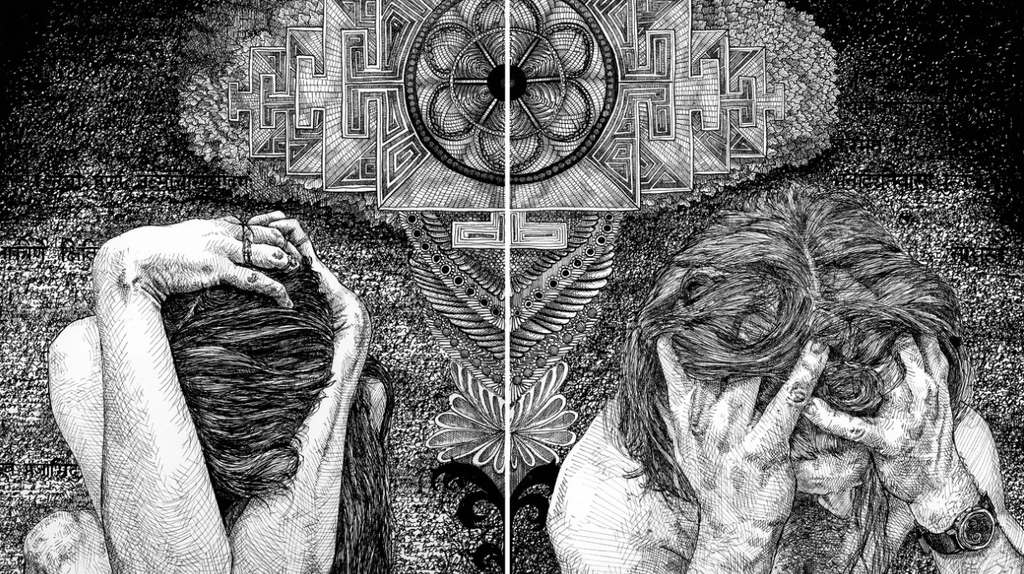
If you are a fan of dark art and heavy music, there's a very good chance that you've stumbled across the work of New York artist Caroline Harrison. She has worked some of our own favorites in the music community like SunnO))), Pig Destroyer and Inter Arma. Harrison's work is a juxtaposition of haunting, figures seething with pain or disfigurement against a soothing meditation of detailed geometry behind them. It's an interesting experience: you want to look deeper, but your eyes are torn between the grotesque majesty of what's before you. Dark Art & Craft immediately became obsessed and were honored that she was interested in discussing her work on a deeper level. We had a chance to chat with her this past week, and explored topics such as her upcoming exhibitions, how she got involved as an illustrator for the heavy music community and what she thinks is going to be the demise of society as we know it.
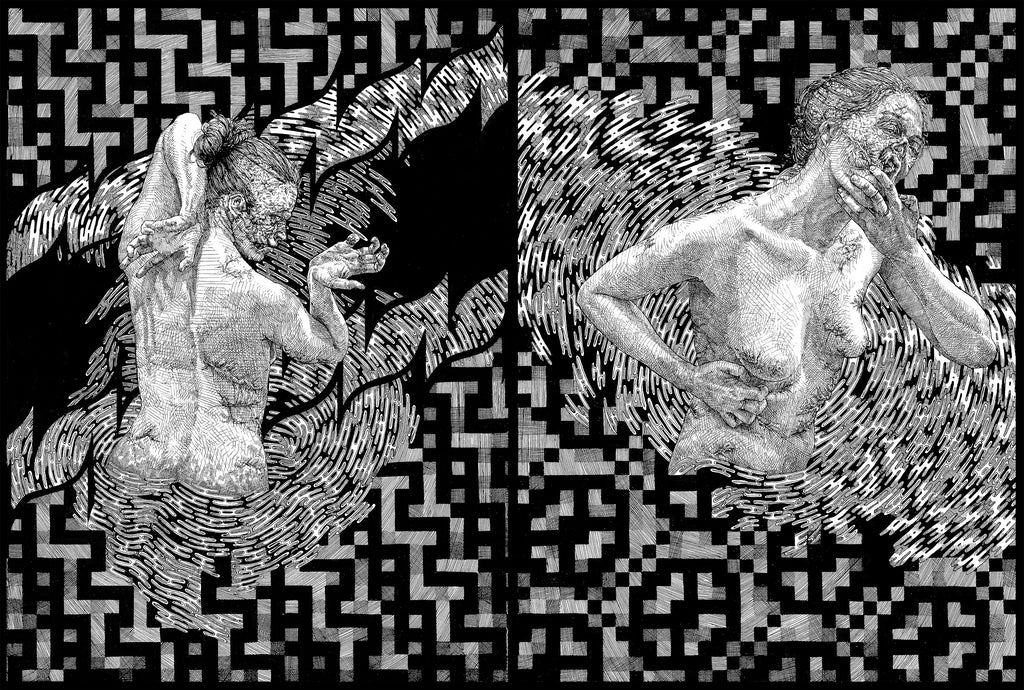
Tell us your name where you are at and what you do.
Hello! I'm Caroline Harrison, and I'm an artist based in Queens, NY. I draw, and sometimes bands put the things I’ve drawn on t-shirts or album covers.
This is something we like to ask everyone, so bear with us. What does dark art mean to you?
I think of it as sort of an umbrella term that describes art that confronts and explores (and possibly makes peace with) a lot of the really scary shit that comes with being a person in this world. I know the term can call to mind a very specific type of aesthetic but I prefer to think of it as a much broader set of parameters.
In a sentence, describe your work.
I draw things that both fascinate and scare me about bodies.
Your work is INCREDIBLY detailed, holy shit. What are some of the techniques and masters of yesteryear who inspired you to do what you do?
It’s funny because I think a lot of the artists that really drew me into making art aren’t people I think I have much technically in common with. I bought a book collecting the best Vertigo Comics covers with my babysitting money from Million Year Picnic in high school, and the work in there made a huge impression on me. I also loved the illustrations in the fairy tale and myth collections that I had. Artists like Dave McKean, Glenn Fabry, Danijel Zezelj, or Arthur Rackham didn’t necessarily influence the way I make stuff but they certainly got me really excited about making stuff. I guess the use of ink in a lot of comic books is probably the closest influence on how I draw, even though the overall effect of what people like Charles Burns or R. Crumb do is pretty different from what I end up doing. None of those are particularly yester-y, of course, but man, I got excited about drawings and paintings by Dave McKean in that super fevered way that teenagers are particularly good at getting. I had a copy of Arkham Asylum (he illustrated the Grant Morrison graphic novel) that I would look at over and over and over again.
That’s not to say that I don’t love a lot of the more traditional figures in art history. Etchings by Goya and Rembrandt and the anatomical illustrations in Vesalius’ De Humani Corporis Fabrica definitely shaped the way I think about drawing shape and volume. I’m also interested in the history of science and medicine, so I’ve spent a lot of time looking at old medical illustrations. I’m a little obsessed with Hieronymous Bosch, and I recently discovered Ivan Albright and Anders Zorn. And I know they’re kinda considered to be cheesy but there’s a rich narrative quality to a lot of the pre-Raphaelite paintings that I always found really appealing. And of course, who doesn’t love a Caravaggio or a Gentileschi? But as far as techniques for how I approach my own work, I feel like that’s just been a lot of trial and error. If I try a new technique to make a piece, it’s usually pretty clumsily done, and I don’t necessarily do it the way it’s supposed to be done. I just kinda muddle through until I find a thing I like and then I keep refining it from there. But I also think it’s important to keep an eye out for things you like, and things that inspire you, and it’ll sort of naturally creep into your work over time if it’s right. Like, I don’t know anything about architecture really but I love little ornamental flourishes you find on buildings or in carved woodwork and stuff like that, and so that stuff started making its way into what I do.
When did you decide that art was something you loved to do? Was this a childhood dream, or something that just happened upon you? Did you go to school for art? Any and every detail please and thank you!
I always really loved drawing, pretty much as far back as I can remember. And I was really, really lucky to have great teachers, especially in high school, who encouraged that interest, and encouraged experimentation. So when I started looking at colleges, I was looking at a mix of art schools and liberal arts schools with strong studio art programs. I think my parents are probably still pretty relieved that I decided to go to a liberal arts program instead of art school. I did major in art, but my undergrad program was very much an art program at a non-art school. We had to learn the foundations of certain disciplines to graduate, of course, but we weren’t being drilled the same way someone at an actual art school might. But on the flip side, it meant that I had a lot of freedom to study other academic subjects I was interested in, like the history of science and medicine (I minored in something called “science, technology, and society” which was an interdisciplinary department that I really should have double majored in) or archaeology or gender studies or American politics. And I think getting to study a broad range of academic subjects had a pretty strong influence on how I think about making work. But it also meant that getting my technical drawing abilities squared away has taken a bit longer, and I feel like I’m still sort of constantly playing catch up in that regard. Depending on what I’m drawing, I still rely pretty heavily on photo-reference (usually photos I take) and my drawing technique has definitely led to some wrist, shoulder, and elbow pain. But as I alluded to earlier, sometimes the lack of technical background means I blunder into something that I think looks cool.
Can you talk more about the decomposing elements of your work? Let's get real and let's get in depth if you can.
I started drawing the sort of gloopy, mutated, grotesque fleshy forms as a way of exploring ideas of mental illness and other so-called invisible illnesses, and just human fragility in general. A lot of this work honestly started as a means of trying to make sense of my own mental problems and my body’s fragility, and bled into my fascination with the history of medicine. People who are visibly ill get treated very differently than people who might have a disease with no immediately apparent symptoms. There’s a weird sort of burden of proof for anyone dealing with something that people can’t see right away. I started thinking about externalizing these less visible illnesses. I found cancers or cysts and autoimmune disorders to be appealing metaphorical territory since they sort of all arise when some regular, helpful function of the body starts to misfire (an explanation that oversimplifies things somewhat, but there’s a lot of really rich visual territory there). My interest in this imagery then expanded into scarring and early reconstructive surgery for facial trauma. Even aside from the beauty in the tenacity of a body that tries to heal itself after, say, having a nose shot off, there’s also a lot of really interesting patterning in the scar tissue itself. Scar tissue is oddly delicate and lovely in its own way!
The weird fleshy oozy rotting masses I draw are loosely based on instances where the body is either healing itself after trauma or growing out of control or attacking itself, so decomposition is just one facet of the source material I use. I have all sorts of weird folders on my computer for different types of tumors or cysts or scar tissues or festering wounds because I think the way our bodies fight back when things go wrong is really beautiful to behold, though often fraught and tragic. Decomposition is one possible interpretation of a lot of the visible trauma on the bodies I’ve been drawing lately, and I think it’s a valid (and thoughtful!) one.
When you scroll up and down your feed, you notice a ton of musical content peppered throughout your feed. Can you talk more about your involvement in the music community, and how you as an illustrator became involved in that community?
The short version is that I became involved because I’ve always really loved music. The long version is that my love of music has connected me to a lot of really amazing people over the years, including my partner of over a decade. He’s probably best known for being the vocalist of Pyrrhon, and I’ve done the art for all of their releases and most of their merch. As a member of the larger music community, I’ve had a few other roles as well, from photographing shows for BrooklynVegan and Invisible Oranges to managing the social media presence at Saint Vitus Bar in Brooklyn.
The illustration side of things happened kinda organically. Pyrrhon was looking for art, and I was someone who knew them all really well, and understood the overall aesthetic of the band. I did an unspeakably terrible cover for their first EP, and then redeemed myself with the cover of their first full length. But in 2012 or 2013 (I think?) they were looking for a cover to put on a demo that they hoped to shop around to labels, and I surprised both the band and myself with a small illustration of a decaying rat ouroboros. Those songs ended up on their sophomore LP The Mother of Virtues, and the work I did for that cover is definitely one of my favorite things that I’ve ever done—it’s also probably the first piece I did after college where I thought “oh man, this, this is the thing I want to do. I can actually do this.” The relationship I have with Pyrrhon is obviously pretty unusual—I mean, I’ve lived with Doug for going on 10 years now—and it’s enabled me to prove to myself and others that I’m actually capable of being an artist. And that’s a sort of funny thing! It took a really long time for me to be able to confidently say “I’m an artist.” I still kinda struggle with it because I’m not sure I am really deserving of being able to call myself an artist, but I also know a lot of people I’d consider WAY more legit artists than me who have said similar things.
When it came to getting work with other bands, I took a sort of inactive approach to it. I’m bad at selling myself or my work. I’d much prefer it speak for itself. And I don’t really have a ton of extra time since I do have a day job (New York is expensive / I need health insurance) so I’ve got limited availability to take on clients or pitch people on working with me. I think the only band I’ve ever actually approached about doing work for has been Yautja (if I’m wrong about this and I asked your band if I could do work for you, you’re welcome to publicly shame me for it), which I think is both demonstrative of my total lack of skill in promoting my own work, and of the unique way in which the heavy music community in particular engages with visual art. But every time someone emails me or messages me about doing work, whether it pans out or not, I’m still kind of stunned and humbled that I came to mind for this person. I am so, so lucky that I’ve gotten to work with bands and labels that I like and respect, and it’s something that I think has happened for me because I’ve been showing up at shows, said yes to opportunities, and been persistent about continuing to make new work. For instance: I got to do a shirt for SunnO))) recently, and I know that it’s because I said yes to a SunnO))) themed art show that you (hi, Steph!) curated in Boston, and because I later re-shared that piece and tagged SunnO))) in it on Instagram. But I think illustrating for music is really interesting because there is that social aspect to it, and with metal in particular, a lot of people at shows make music or art themselves. And social media has sort of changed the dynamic in that the social interaction doesn’t always get limited to concerts anymore. People add each other on social networks and then they end up seeing (however passively or actively) what that person creates. It’s really cool!
Three unexpected Caroline Harrison factoids. Give them to us please and thank you. (Are you into toddler jungle gym parkour, do you have a magnificent collection of feral cat hair, etc.)
I love (and am borderline obsessed with) dogs, particularly bear-sized dogs that think they’re teeny little lap dogs. You know how eight-year-old kids can tell you everything about one subject? Like, ponies or dinosaurs or airplanes? I’m like that but with dog breeds (though I definitely encourage anyone considering a dog to adopt one instead of shopping for one, and if for some reason adoption isn’t possible for you, finding a responsible breeder since purebreds can be saddled with awful, awful health problems. But if anyone needs to rehome a very gentle Greater Swiss Mountain Dog, I’m your gal). I really enjoy watching objectively bad action movies and have seem some atrocious things starring Jason Statham. I like going to the opera, and I cry during the curtain call every time.
One of the cool things about being a creative is meeting other creatives and becoming friends with other creatives. Tell us a few of your favorite artist accounts, and why you love them so much.
Oh man, Instagram has been SO good to me with regards to discovering new work, but also with regards to teaching me new things. I love Allison Sommers’ work, and she also posts some really engaging behind-the-scenes content (and some excellent photos of her dog). I've actually learned a bit about using gouache by checking out some of her older posts. Rebecca Morgan makes these really brutal but also really humorous pieces that are sort of as if someone shoved middle America into a blender with classical art history. But, she also regularly takes the time to answer questions from people who follow her and she’s REALLY generous about sharing her own experiences and being pretty candid about the whole thing. Even if you don’t like her work, I think you can learn a lot from her feed, and she’s a really valuable voice in the art community on Instagram. I also really love Parker Jackson’s account. Every so often, he’ll post a series of stories about some of his favorite art historical topics and it’s always super informative. But I could honestly go on and on and on about all the amazing art that’s on Instagram (I’m on that platform way more than I should be).
We are in high holy season as far as dark art and dark events. Can you give us (I know this is going to be hard) FIVE different things that you think that everyone should attend or be a part of, pretending like time or money were not objects.
Okay so: plug for The Convent, because I'm lucky enough to be a part of a show that's opening there on 11/8 with Brian Sheehan and Bill Ross, and before that I’ll have a piece in a group show that The Order of the Thinned Veil is holding on 10/26, also at the Convent. The Convent is a unique space in Philly (it's literally an old convent) that’s super plugged into their local art & music scenes, run by wonderful people, and at least one dog lives there, so really, it’s perfect. So that’s two.
If you're in New York, I think it's crucial to keep an eye on gallery shows and museum exhibitions. There’s SO MUCH happening there! It’s criminal not to take advantage of it. I’m really excited to check out Hayv Kahraman at Jack Shainman, Shona McAndrews at Chart, and I think both are running through the end of October? Plus, Swoon has a show opening at the New York location of Jeffrey Deitch in November, and Rebecca Morgan’s show at Asya Geisberg is up until November 2nd. This is turning into a lot more than five. But all of these things are free! Galleries are FREE. Take advantage of that crisp fall weather, mark a few galleries you want to check out, grab a warm beverage, and go for a walk.
Last one, but I’m gonna mention it because why not: if you’re in Boston, you have got to check out the Hyman Bloom exhibit at the MFA. He’s a new discovery for me, but he made these incredible, expressive, bold, big paintings of corpses in various states of decomposition—really truly gorgeous stuff. The colors are inSANE.
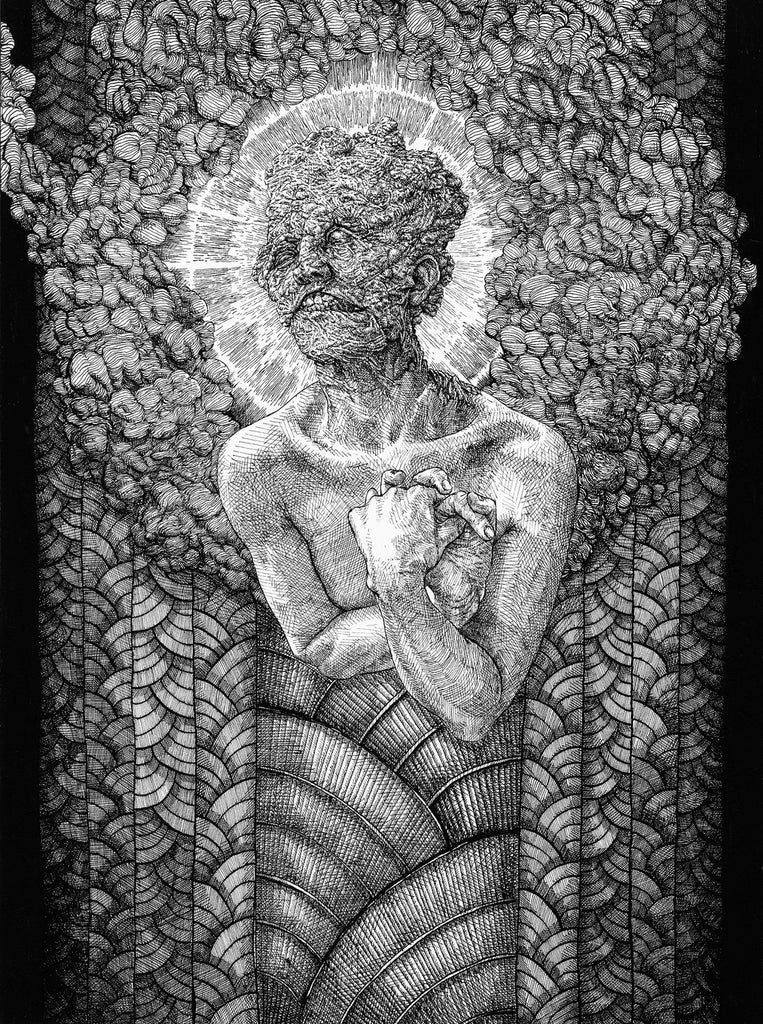
The long expected apocalypse comes. We are now the dystopian future we have all, in some way expected. Tell us what happened to get us there and what is your post apocalyptic survival edge (are you an amazing forager, good at hiding, you can make tiny hats out of sticks, etc.)
It’s definitely brought about by climate change or it’s something else that gets triggered by climate change (like a global pandemic or something) and it’s definitely already happening. We end up totally unprepared to cope with it because a widening wealth gap has enabled a select few to hoard resources, and the creep of fascism favoring a climate-denying ruling class has left the rest of us totally fucked. I took a few survival classes when I was a kid (I spent a lot of time in the woods) but I think (in part due to some minor but chronic health problems) I’d be pretty ill-prepared to survive an apocalypse. I’m sure an antibiotic-resistant superbug that loves the increased global temperature would kill me off pretty fast. Or my various food allergies would mean I’d starve. I can definitely make some tiny hats out of sticks though, so at least I’ll go out with a jaunty cap on my fevered, underfed, diseased dome.
What is some helpful tidbit of advice you have for the creatives that are reading this article?
Honestly, just keep doing the work that you’re doing, talking to people about it, and striving to get better. Every piece you make, every informal sketch, you learn things. A lot of that also means that you have to show up, whether it’s at art shows, or music shows if that’s what you’re into, or online if you’re in a remote place. I know that’s really hard for a lot of people who are more on the introverted side. I cannot count the number of times I’ve gone to an opening with the intention of introducing myself to the artist and then chickening out, so I feel that pain, but it’s so important to cultivate relationships. And don’t get bogged down in your social media numbers. Social media is a tool, but it’s a finicky, shitty thing. What works one day may not work the next. If you stumble on some success, awesome! You can guess at what worked in that post. But don’t let your social media dictate how you make work (this is a recipe for making bad work in nearly all instances), and don’t tie your self worth to your Instagram account performance.
Look, Instagram does really suck in a lot of ways, but it also gives you a chance to follow what people are making, learn a little about their art practice, and leave comments letting them know that you like their work. There are a lot of things to hate about social media, and to be wary of, but I think this much is worth celebrating. And if you like someone’s work, make the extra effort and leave a comment. It costs you nothing, it boosts the post’s visibility on the platform (be it Instagram, Facebook, Twitter), and it probably makes that artist feel pretty good. Making art can be really stupid and hard and it’s not exactly financially rewarding (I have a day job; a lot of people I know have day jobs). If you like an artist but can’t afford an original piece, to contribute to their Patreon, or you are drowning in artist prints, you can just drop them a comment to let them know that you like their work, or even share it (with proper attribution!) on your own account. But don’t be pushy, and don’t get mad if they don’t reciprocate, and always be courteous. They’re busy! They might also be shy! They might simply not have seen the comment or the message!
To support Caroline, grab some of her work here, check out her website and follow her on Instagram! Tristate area friends, make sure to check out Palest Fire, a group show featuring Harrison at the Convent in Philadelphia, PA.


